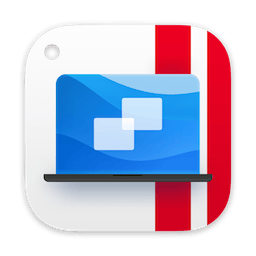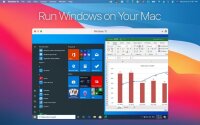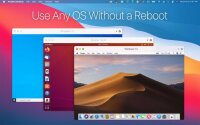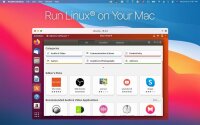Parallels Desktop 26.1.1-57288 fix v2

Parallels Desktop is one of the oldest and most popular applications for virtualization on macOS. There are quite a few options out there for Mac users who want to run other operating systems on their Apple devices, but none are quite as intuitive and novice-friendly as Parallels.
This app allows you to Run Windows, various flavors of Linux, ChromeOS, Android, and many other operating systems in virtual machines, and it makes setting up and configuring these VMs incredibly straightforward. Much of the process is automated, and the virtualized OSes integrate well with macOS.
It really is that simple. Compared to alternatives like VirtualBox or VMware, it is much easier to create a virtual machine and install an OS. For instance, if you want a Windows 11 VM, the startup wizard guides you through the entire process. It only takes a few clicks and absolutely no technical knowledge.
If you skip the initial Win10 wizard, Parallels still has an installation assistant that can help you set up Windows, Linux, and many other operating systems. The Windows 10 Test and Development environments are available for free, as are numerous Linux flavors and Android, and you can even install macOS from the recovery partition or convert a Boot Camp installation to a VM.
Aside from installing Windows via Boot Camp, which isn't likely to be supported on Apple Silicon, Parallels offers possibly the most seamless experience when running another operating system on your Mac.
MacBook Pro users can add Windows apps to the Touch Bar, Office integration lets documents in Safari open in their native Windows apps, and full support is available for Retina displays for the best visual experience.
Sharing files between your Mac and Windows VM could not be easier, as files on the desktop are instantly accessible from either OS, no matter where they were created.
If you want to take things one step further, just enable Coherence Mode. Once it is active, all applications in your Windows VM will appear in separate windows directly on your Mac's desktop, almost as if they were running natively on macOS.
Of course, Parallels Desktop is available in multiple editions, with the Pro and Business variants geared towards professionals and enterprises respectively. While the Standard edition includes most features, it limits the amount of RAM and virtual CPUs you can use for each VM and lacks some advanced deployment and management tools.
These include integration with Docker, Vagrant, and Microsoft Visual Studio, among others, VM transferring and deployment capabilities, debugging tools, and centralized administration and management.
Whether you're just starting out or you have a lot of experience with running VMs, nothing can beat the streamlined experience you get with Parallels, and it doesn't lose out to its competitors when it comes to the number of available features either.
With Boot Camp seemingly doomed on Apple Silicon, Parallels will likely be one of the few virtualization options available for M1 Mac users.
What's New:
Version 26.0
The new major Parallels Desktop version 26.0.0 (build 57238) includes many under-the-hood upgrades aimed at better supporting the latest version of macOS. Parallels Desktop 26 follows Parallels Desktop 20 to bring the version number in line with Apple’s new macOS versioning.
The release delivers the following improvements:
All editions of Parallels Desktop 26 for Mac
- Ready for macOS Tahoe 26.
Parallels Desktop 26 supports the upcoming macOS Tahoe 26 as a primary OS on Mac and as a virtual machine, so you can upgrade your Mac computers once the new operating system becomes available.
Look and Feel
- Brings updated icons across the board on Macs running macOS Tahoe 26.
Windows on Mac
- Enables Windows to accurately assess the available disk space on your Mac, helping you avoid harming your Mac’s responsiveness by installing overly large Windows software.
- Improves the behavior of full-screen Windows apps in Coherence mode, enabling your Mac to go to sleep mode normally.
- Fixes the issue that caused Persona 5 Royal to crash on launch in Windows 11 virtual machines.
Linux on Mac
- Apple silicon Macs: Adds out-of-the-box support for new Linux distributions, such as Ubuntu 24.04.2, Fedora 42, Debian 12.6, and Kali 2024.2.
- Intel Macs: Adds out-of-the-box support for new Linux distributions, such as Ubuntu 24.04, Fedora 40, Debian 12.6, and Mint 21.3.
- Fixes the issue that prevented Parallels Tools for Linux from installing correctly on CentOS 10 running on Intel Macs.
Parallels Desktop 26 for Mac Business & Enterprise Edition
- Adds the ability for system administrators to manage and monitor virtual machine software updates using Jamf scripts.
- Regenerates unique identifiers for virtual machines deployed from Golden Images to ensure smooth Intune enrollment.
What was deprecated or removed from Parallels Desktop 26
According to the statistics from the users who participate in the Parallels Customer Experience program, some product features are used very seldom or not at all. We have decided to either stop supporting them or completely remove them from Parallels Desktop and focus on frequently used features and further enhancements.
Below is the list of features that are no longer supported and have been removed in Parallels Desktop for Mac 26:
- Installing Parallels Desktop on Macs running macOS Monterey 12.
- Shared Bluetooth functionality. Bluetooth devices (e.g., keyboards, mice, or game controllers) connected to your Mac will continue to work normally in virtual machines.
Note: To connect a Bluetooth device directly to a virtual machine, consider using a USB Bluetooth dongle. - USB and network kexts (kernel extensions). This deprecation affects virtual machines that run on Intel Macs using Parallels hypervisor; such machines will continue supporting USB and network adapters in kextless mode.
- Deferred activation.
- Designating a custom update server in the deployment package settings.
- Synchronization of virtual machine color tags between the Parallels Desktop Control Center and macOS Finder.
- The option to install Parallels Toolbox for Windows in a Windows virtual machine using the Parallels Desktop menu.
Screenshots:
- Title: Parallels Desktop 26.1.1-57288 fix v2
- Developer: Parallels Holdings Ltd.
- Compatibility: macOS 12 or later
- Language: Multilingual
- Includes: K
- Size: 226.33 MB
- visit official website



Comments 1
Users of Guests are not allowed to comment this publication.